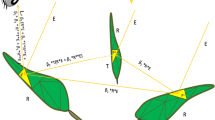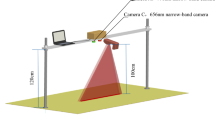Abstract
An accurate and operational bidirectional reflectance distribution function (BDRF) canopy model is the basis of quantitative vegetation remote sensing. The canopy reflectance should be approximated as the sum of the single scattering reflectance arising from the sun, ρ 1, and the multiple scattering reflectance arising from the canopy, ρ m, as their directional characteristics are dramatically different. Based on the existing BRDF model, we obtain a new analytical expression of ρ 1 and ρ m in this paper, which is suitable for different illumination conditions and different vegetation canopies. According to the geometrical optic model at the leaf scale, the anisotropy of ρ 1 can be ascribed to the geometry of the object, sun and the sensor, multiple scale clumping, and the fraction of direct solar radiation and diffuse sky radiation. Then, we parameterize the area ratios of four components: the sunlit foliage, sunlit ground, shadow foliage and shadow ground based on a Poisson distribution, and develop a new approximate analytical single scattering reflectance model. Assuming G=0.5, a recollision probability theory based scattering model is developed which considers the effects of diffuse sky radiation, scattering inside the canopy and rebounds between the canopy and soil. Validation using ground measurements of maize and black spruce forest proves the reliability of the model.
Similar content being viewed by others

References
Chandrasekhar S. 1960. Radiative Transfer. New York: Dover Publications Inc. 53
Chen J M, Leblanc S G. 1997. A four-scale bidirectional reflectance model based on canopy architecture. IEEE Trans Geosci Remote Sens, 35: 1316–1337
Fan W L, Chen J M, Ju W, Zhu G. 2014. GOST: A geometric-optical model for sloping terrains. IEEE Trans Geosci Remote Sens, 52: 5469–5482
Huang D, Knyazikhin Y, Dickinson R E, Rautiainen M, Stenberg P, Disney M, Lewis P, Cescatti A, Tian Y, Verhoef W, Martonchik J V, Myneni R B. 2007. Canopy spectral invariants for remote sensing and model applications. Remote Sens Environ, 106: 106–122
Huang H G, Qin W H, Liu Q H. 2013. RAPID: A radiosity applicable to porous individual objects for directional reflectance over complex vegetated scenes. Remote Sens Environ, 132: 221–237
Jupp D L B, Strahler A H. 1991. A hotspot model for leaf canopies. Remote Sens Environ, 38: 193–210
Knyazikhin Y, Martonchik J V, Myneni R B, Diner D J, Running S W. 1998. Synergistic algorithm for estimating vegetation canopy leaf area index and fraction of absorbed photosynthetically active radiation from MODIS and MISR data. J Geophys Res, 103: 32257–32275
Knyazikhin Y, Schull M A, Xu L, Myneni R B, Samanta A. 2011. Canopy spectral invariants. Part 1: A new concept in remote sensing of vegetation. J Quant Spectrosc Ra, 112: 727–735
Kuusk A. 1991. The hot spot effect in plant canopy reflectance. In: Myneni R B, Ross J, eds. Photon-Vegetation Interactions: Application in Optical Remote Sensing and Plant Physiology. New York: Springer-Verlag. 139–159
Li X, Strahler A H. 1985. Geometric-Optical modeling of a conifer forest canopy. IEEE Trans Geosci Remote Sens, GE-23: 705–721
Liang S. 2005. Quantitative Remote Sensing of Land Surfaces. New York: John Wiley and Sons. 76–134
Mõttus M. 2007. Photon recollision probability in discrete crown canopies. Remote Sens Environ, 110: 176–185
Müller-Linow M, Pinto-Espinosa F, Scharr H, Rascher U. 2015. The leaf angle distribution of natural plant populations: assessing the canopy with a novel software tool. Plant Methods, 11, doi: 10.1186/s13007-015-0052-z
Nilson T. 1971. A theoretical analysis of the frequency of gaps in plant stands. Agric Meteorol, 8: 25–38
North P R J. 1996. Three-dimensional forest light interaction model using a Monte Carlo method. IEEE Trans Geosci Remote Sens, 34: 946–956
Panferov O, Knyazikhin Y, Myneni R B, Szarzynski J, Engwald S, Schnitzler K G, Gravenhorst G. 2001. The role of canopy structure in the spectral variation of transmission and absorption of solar radiation in vegetation canopies. IEEE Trans Geosci Remote Sens, 39: 241–253
Qin W, Gerstl S A W. 2000. 3-D scene modeling of semidesert vegetation cover and its radiation regime. Remote Sens Environ, 74: 145–162
Qin W, Jupp D L B. 1993. An analytical and computationally efficient reflectance model for leaf canopies. Agric For Meteorol, 66: 31–64
Smolander S, Stenberg P. 2005. Simple parameterizations of the radiation budget of uniform broadleaved and coniferous canopies. Remote Sens Environ, 94: 355–363
Stenberg P. 2007. Simple analytical formula for calculating average photon recollision probability in vegetation canopies. Remote Sens Environ, 109: 221–224
Verhoef W. 1984. Light scattering by leaf layers with application to canopy reflectance modeling: the SAIL model. Remote Sens Environ, 16: 125–141
Xu X. 2005. Remote Sensing Physics (in Chinese). Beijing: Peking University Press. 45–121
Yan B Y, Xu X R, Fan W J. 2012. A unified canopy bidirectional reflectance (BRDF) model for row crops. Sci China Earth Sci, 55: 824–836
Zhang R H, Tian J, Li Z L, Su H B, Chen S H, Tang X Z. 2010. Principles and methods for the validation of quantitative remote sensing products. Sci China Ser Earth Sci, 53: 741–751
Zhou X, Tao S, Yao K. 1991. Advanced Atmospheric Physics (in Chinese). Beijing: China Meteorological Press
Zhu X H, Feng X M, Zhao Y S. 2012. Multi-scale MSDT inversion based on LAI spatial knowledge. Sci China Earth Sci, 55: 1297–1305
Acknowledgements
The authors gratefully appreciate the reviewers for their valuable and insightful comments and suggestions and International Science Editing to polish our paper. This work was supported by the National Natural Science Foundation of China (Grant Nos. 41271346, 41571329 & 41230747) and the Major State Basic Research Development Program of China (Grant No. 2013CB733402).
Author information
Authors and Affiliations
Corresponding author
Electronic supplementary material
Rights and permissions
About this article
Cite this article
Xu, X., Fan, W., Li, J. et al. A unified model of bidirectional reflectance distribution function for the vegetation canopy. Sci. China Earth Sci. 60, 463–477 (2017). https://doi.org/10.1007/s11430-016-5082-6
Received:
Accepted:
Published:
Issue Date:
DOI: https://doi.org/10.1007/s11430-016-5082-6



